Want to get toned, rock-hard biceps without expensive gym equipment or machines? Bodyweight bicep exercises are the perfect way to sculpt and define your arms at home using your bodyweight.
Bodyweight workouts are easy to do and can be done anywhere. When done correctly, they work all types of muscles and make a good strength workout.
The great news is that bicep curls and chin-ups aren’t the only exercises that work your arms.
We’ll show you some good exercises for your biceps that you won’t find at the gym. Clear photos and step-by-step instructions teach proper form to maximize results.
All the bodyweight biceps exercises below can be performed by both men and women for huge gains and strength.
Let’s get started!
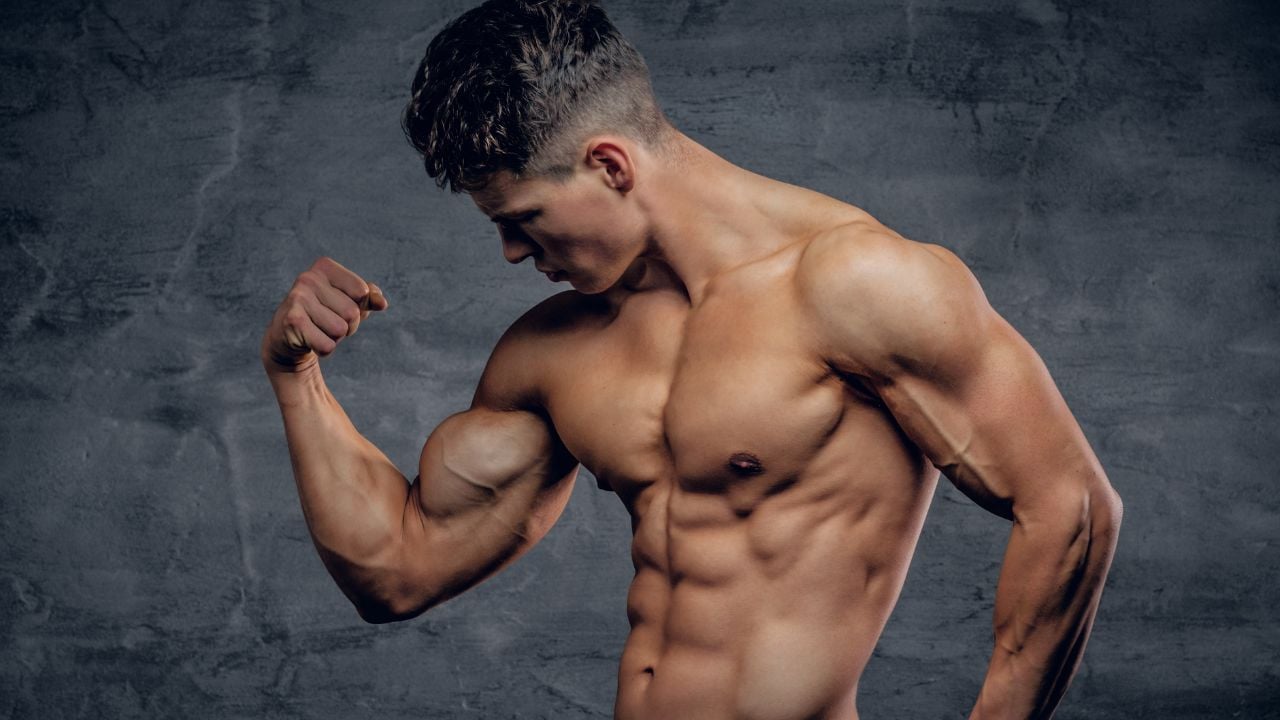
- How to Build Bigger Biceps At Home With Bodyweight
- 1. Understand the Muscles You Are Training
- 2. Know the Right Exercises
- 3. Achieve Balanced Strength Development
- 4. Train Using Slow Tempo and Control Reps and Sets
- 5. Progressive Overload for Maximum Gains
- 15 Best Bodyweight Biceps Exercises At Home
- 1. Inverted Row
- 2. Chin Up
- 3. Pull Up
- 5. Bicep Leg Curl
- 6. Towel Bicep Curls
- 7. Incline Push-Ups
- 8. Isometric Chin-ups
- 9. Archer Pull-Ups
- 10. Lateral Plank Walk
- 11. Reverse Grip Push-Ups
- 12. Archer Push-Up
- 13. Chaturanga
- 14. Dive-bomber push-up
- 15. Towel Hammer Curl
- Bodyweight Bicep Workout Routine
- Beginner Bodyweight Bicep Workout Plan
- Intermediate Workout Routine
- Frequently Asked Questions (FAQ’s)
- The benefit of a Bodyweight Biceps Workout
- How often should we work on our biceps?
- Is it normal for my arms to be in pain after the workout?
- How to combine bicep exercises into a great home workout:
- Can you train biceps with bodyweight?
- Can you get big arms with bodyweight exercises?
- How can I build my biceps without weights?
- How can I build my bicep at home?
- Takeaways
How to Build Bigger Biceps At Home With Bodyweight
Building biceps at home is possible! With this guide, you can get the strong and toned arms you want without heading to the gym.
Discover how to use simple, everyday equipment or bodyweight to build your strength and achieve bigger biceps.
1. Understand the Muscles You Are Training
Before you start any bicep exercises, it’s important to understand the muscles you are training.
Your biceps have two main muscles: a short head and a long-head bicep.
The biceps is one of four muscles that comprise the upper arm, alongside the brachialis, brachioradialis, and coracobrachialis.
To effectively target these muscle groups, consider adding various exercises that work each one separately into your routine.
2. Know the Right Exercises
To effectively target your bicep muscles, incorporate exercises like bodyweight rows and chin-ups into your routine.
- Bodyweight rows and curls build the bicep brachii and brachialis muscle.
- Chin-ups focus more on your brachioradialis while also working the other muscles.
Make sure to perform each exercise with proper form to avoid injury.
3. Achieve Balanced Strength Development
For balanced strength development, incorporate exercises for both sides of the arm.
Bicep curls work the bicep muscles, but doing tricep pushdowns is also important for keeping your arm training balanced and getting good results.
Diamond push-ups are great for targeting your triceps.
Read More: 15 Bodyweight Triceps Exercises: Beginner To Advanced
4. Train Using Slow Tempo and Control Reps and Sets
Slower reps allow you to use more control throughout the rep and build overall muscle strength while increasing the demand on your muscles. This can help you target and shape your biceps more effectively.
When performing bicep curls, chin up, and rows, focus on making each rep as slow and controlled as possible.
Aim for 3–4 sets of 10–12 reps to reach your desired muscle fatigue, and then completely rest before attempting any more sets.
Want to take your gains to the next level? Discover your daily calorie needs with our free TDEE calculator.
5. Progressive Overload for Maximum Gains
To maximize bicep strength and muscle growth, you should progressively increase the resistance you lift each time you exercise.
As your muscles become stronger, add more resistance to your bicep exercises so that your body will continue to challenge itself and grow.
Start with a lighter weight and work your way up. Do 3–4 sets of 10–12 reps each time.
This progressive overload method will help ensure maximum muscle growth, strength, and size gains.

15 Best Bodyweight Biceps Exercises At Home
Building strength in your biceps doesn’t require expensive gym equipment. With some simple bodyweight exercises you can do at home, you can work on toning and strengthening your arms without breaking the bank.
Here are 15 exercises to build strong and lean biceps from the comfort of your home.
You can use these as part of a regular workout or as a standalone circuit.
1. Inverted Row
Inverted rows, also known as bodyweight rows, are a great exercise to not only target your bicep muscles, but also build strength in other areas, such as your middle back and core.
It’s putting your body horizontally, making it easier to perform.
In the gym, most people do this exercise on the Smith machine. But, At home, you can also perform the inverted row by lying under a chair, holding the chair’s sides, and pulling yourself up.

How To Do Bodyweight Rows
- Adjust the height of the chair and bar so that it’s a little higher than arm’s length from the floor.
- Lie under the bar with your legs and body straight.
- Grasp the bar with an overhand grip that’s a little wider than shoulder width.
- Keeping your legs and body straight, exhale as you pull your chest up to the bar.
- Hold for a count of two and squeeze your back muscles.
- Inhale as you lower your body until your arms and shoulders are fully extended. Repeat.
Tips
- Do not allow your butt to sag. Flex your tummy, squeeze your butt cheeks, and keep your body stiff from your head to your toe.
- Grab the bar with your hands slightly closer together.
- Make sure you go down completely.
2. Chin Up
One of the best bodyweight exercises for your biceps is the chin-up.
This bodyweight exercise can induce serious muscle growth in the back and biceps.
In this exercise, the palms are faced towards the body. Since the lifter is pulling their own bodyweight, the biceps are usually exposed to loads heavier than what one can lift with a barbell.

How To Do Chin Up
- Grasp a pull-up bar with an underhand grip, hands shoulder-width apart or slightly narrower.
- Straighten your arms, keep your knees bent and cross your lower legs.
- Retract your shoulder blades and pull your body until your chin aligns with the bar.
- Pause at the top for one to two seconds, with the biceps under maximum tension.
- Slowly lower to the start position.
Tips
- I do not get it; usually, you are doing half reps and chasing numbers.
- Lower to almost full extension of the elbow, but avoid locking out completely.
3. Pull Up
The pull-up is an upper-body strength movement that targets your back, chest, shoulders, and biceps.
Performing a pull-up is often a challenge for beginners and even experienced athletes.

How To Do Pull Up
- Grasp the pull-up bar with an overhand grip, shoulder-width apart.
- Tighten your abdominal muscles and pull your shoulder blades back and down.
- Use your back and biceps muscles to pull your body up towards the bar until your chin clears the bar.
- Control the descent and lower yourself back down to the starting position.
Tips
- Go full range of motion and keep form correct.
- Avoid jerky movements and keep them controlled.
5. Bicep Leg Curl
The bicep leg curl is a very effective bodyweight isolation exercise for building muscle and strength.
Every so often we don’t have access to equipment, but that’s not an issue with the bicep leg curl, as you only need your arms and legs.
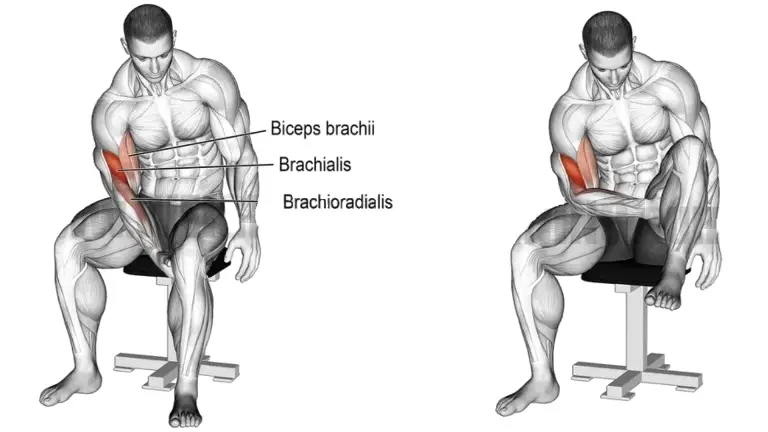
How To Do Bicep Leg Curl
- Sit on a chair as close to the edge as possible.
- Then, place your right hand under your left thigh at the crease between your hamstrings and calves.
- Slowly curl your right up as high as possible—Exhale during this exercise portion.
- Hold for a couple of seconds. Then, slowly lower your leg back down, so your foot is just above the ground—Inhale during this exercise portion.
- Repeat for the desired number of reps.
- Repeat the exercise with your left arm.
Tips
- Try to get as much range of motion as possible.
- You can perform a variation of the bicep leg curl lying down.
6. Towel Bicep Curls
Towel bicep curls are an innovative, equipment-free exercise that targets the biceps using a towel and your body’s own resistance.
You can perform this exercise by standing with your back against the wall and grabbing both ends of a towel while putting one foot on a sling.
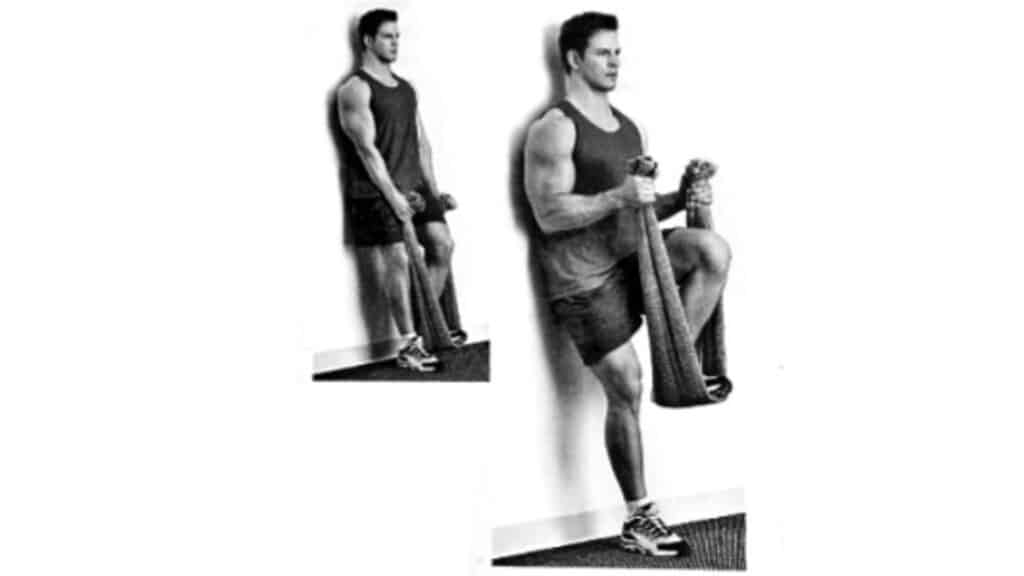
How To Do Towel bicep curls
- Use a long towel and fold or roll it lengthwise.
- Stand with your feet shoulder-width apart.
- Step on one end of the towel with one foot to secure it to the floor.
- Grip the other end of the towel with the hand on the same side (e.g., right foot, right hand). Or from both hands.
- Keep your elbow close to your torso, and pull the towel upwards by bending your elbow, as you would in a regular bicep curl.
- Once your hand is close to shoulder level, hold the position momentarily.
- Slowly lower your hand back to the starting position.
Tips
- Keep your core tight and your shoulders down while doing this exercise.
- Exhale as you curl the towel upward, and inhale when returning to the starting position.
Know More: 7 Best Resistance Band Bicep Exercises For Bigger Arm
7. Incline Push-Ups
Incline push-ups are a variation of the traditional push-ups where the hands are placed on an elevated surface.
This variant shifts some focus to the biceps, although it’s important to note that incline push-ups primarily target the chest, shoulders, and triceps.

How To Do Incline Push-Ups
- Choose a stable surface such as a bench, table, or even a staircase.
- Place your hands on the elevated surface slightly wider than shoulder-width apart.
- Extend your legs back so your body forms a straight line from your heels to your head.
- Slowly bend the arms to lower the chest toward the bench.
- Remember to keep the elbows and arms close to the body.
- Push your body away from the bench by extending your arms.
Tips
- Your elbows should be at a 45-degree angle from your body.
- Avoid sagging your hips or arching your back.
- Stand at a comfortable distance from the bench.
8. Isometric Chin-ups
The Isometric means there is no lengthening or shortening of the musculature, simply striving to maintain one shape.
Isometric holds for biceps: You can think of holding bags of groceries in your hands and your elbows bent at 90 degrees. Your biceps are fully flexed in this position, holding the bags statically in place.
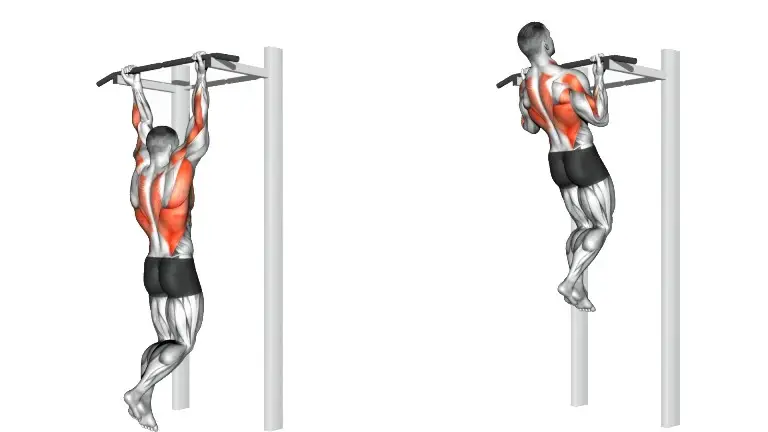
How To Do Isometric Chin-ups
- Grab the pull-up bar with your palms facing you and your hands about shoulder-width apart.
- Pull yourself until your chin is over the bar.
- If you cannot do a chin-up, you can still do this exercise by using a chair or step to jump.
- Make sure your chin is above the bar. Hold for 5 seconds,, then lower down to 90 degrees and hold for,five, then lower down again to just before the bottom.
- Repeat for the desired number of reps.
Tips
- Keep the scapula retracted
9. Archer Pull-Ups
Archer pull-ups are a challenging variation of the traditional pull-up that primarily targets the upper body muscles, including the back, biceps, and shoulders.
This exercise involves pulling yourself up to one side and extending the opposite arm out to the side, mimicking the drawing of a bow, like an archer.

How To Do Archer Pull-Ups
- Grip the pull-up bar with a wide grip, wider than shoulder-width.
- As you pull yourself up, shift your weight to one side, extending the opposite arm straight out to the side.
- Your chin should reach or go slightly above the bar on the side you’re pulling towards.
- In the top position, one arm should be bent, doing most of the pulling, while the other arm is straight and extended.
- Lower yourself back to the starting position in a controlled manner.
- Repeat the movement, alternating the side you pull toward with each rep.
Tips
- Start with fewer reps and increase as you build strength.
- Mastering the archer pull-up takes time and practice.
10. Lateral Plank Walk
The Lateral Plank Walk is a full-body exercise mainly targeting your core, shoulder, and biceps. Take a walk on the wild side as well, as wild as a plank can get.
This move intensely engages your core like a classic plank, but the side-to-side motion also works your arms and delts. Plus, it’ll challenge your balance and stability.
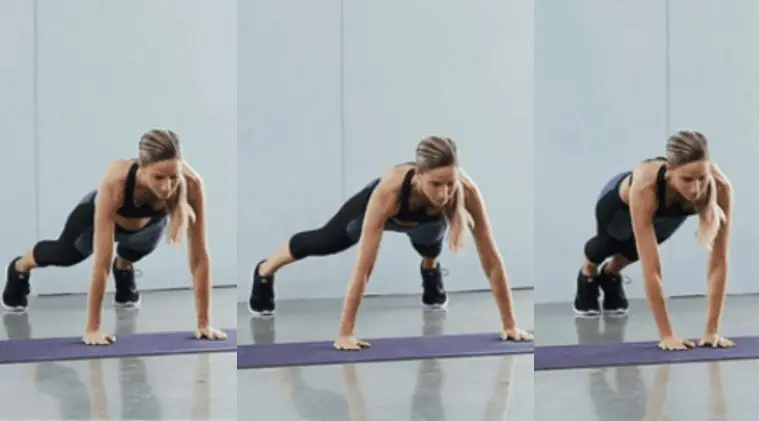
How To Do Lateral Plank Walk
- Start in a high plank position.
- Your body should form a straight line from your shoulders to your ankles.
- Take a step to the right, starting with your right hand and right foot and following with your left hand and foot, maintaining a plank position as you move.
- Do a set number of reps in one direction, and then repeat the same number of reps moving in the opposite direction.
11. Reverse Grip Push-Ups
The reverse grip push-up is a fun and great variation of the standard push-up. The exercise is done with your fingers facing your feet (your palms outward).
Many consider it the “bicep push-up” because of the hand position; it emphasizes your biceps more than the standard push-up.
To make it easier, you can do it on your knee or an inclined surface.
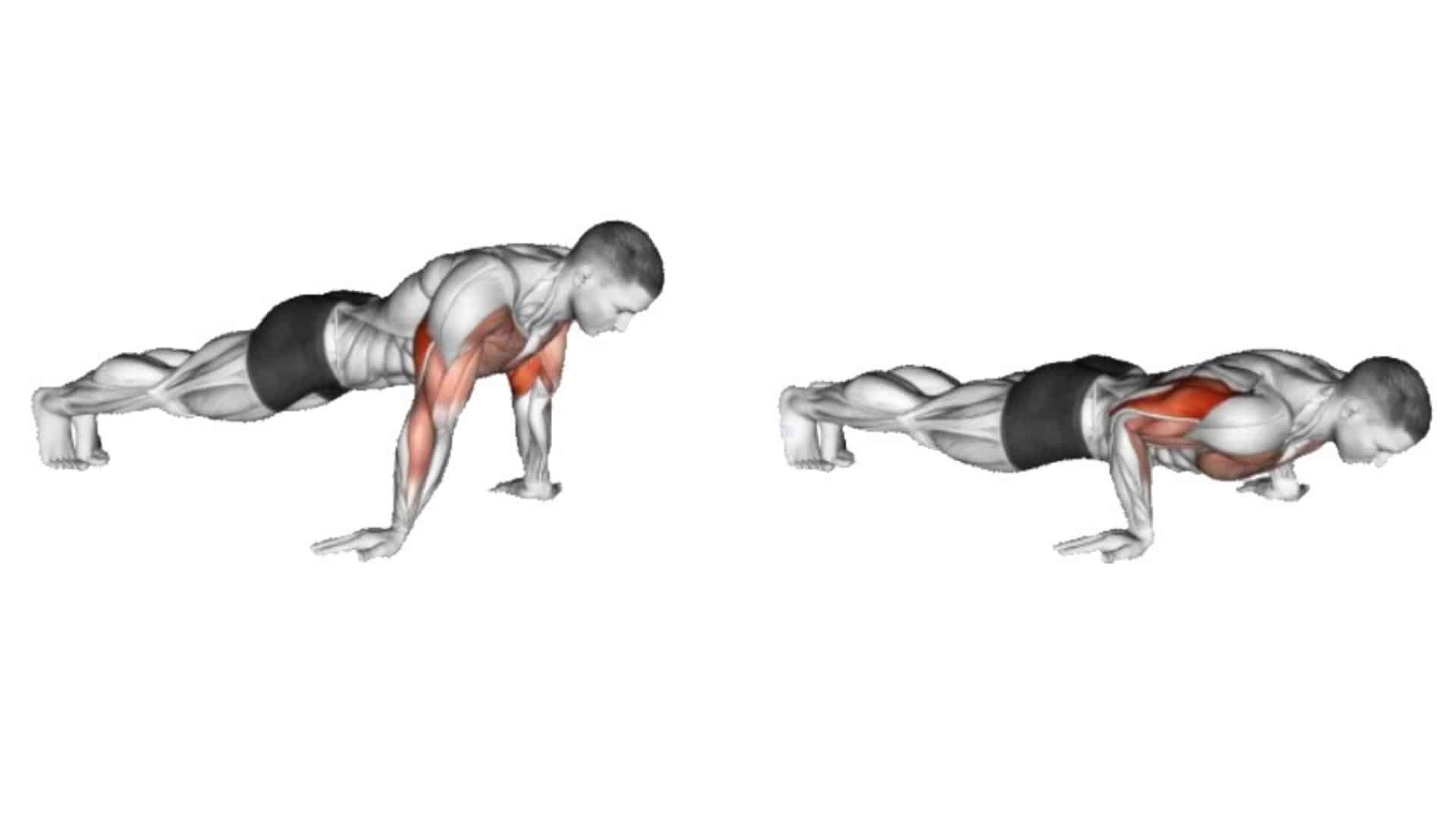
How To Do Reverse Grip Push-Ups
- Start in a standard push-up position and place your hands slightly wider than your shoulders.
- Your palms are flat on the floor, and your fingers point toward your feet.
- Inhale and slowly start to bend your elbows. Do not let your elbows move outwards (away from your body).
- Lower yourself until you are about an inch from the floor. Pause the movement when you are at the bottom for a second.
- Exhale and start pushing your body back up. Push through your palms like you would try to push the floor away from yourself.
- Finish the exercise by extending your arms completely out. Repeat this for however many repetitions you wish to perform.
Tips
- Always make sure to do a proper warm-up, especially focusing on warming up and stretching your wrists!
- Keep your body in a straight line for the entire exercise.
12. Archer Push-Up
In Archer push-up, the arms are kept wider than the normal push-up position and as you lower your body, you transfer most of your weight to one of your hands and incline towards that hand while the other hand is kept straight.
Simultaneously, move your body to both sides. You must maintain a tight, steady, and controlled body to perform archer push-ups.

How To Do Archer Push-Ups
- Start in a standard push-up position with your hands slightly wider than shoulder-width apart and elbows completely locked out.
- Maintain a strong core position and shift your upper body toward your right side. Pull your right chest toward your right hand as you bend your right elbow.
- As you lower toward the right side, allow your left arm to straighten. Your left arm should be fully extended, forming a straight line from your shoulder to your hand.
- Repeat for your desired number of repetitions, and switch sides.
Tips
- Don’t let your hips raise.
- Make sure your body is in a straight line from head to feet.
13. Chaturanga
Chaturanga, also known as Chaturanga Dandasana, is a yoga pose that resembles a low plank or a push-up in its halfway down position.
The term “Chaturanga” comes from Sanskrit, where “Chatur” means four and “Anga” means limb, referring to the four limbs that support the body in this position.
This workout tests how strong your grip is and how long you can hold it for. It helps you tone your arms and strengthens them.

How To Do Chaturanga
- Begin in a standard plank position with your shoulders over your wrists.
- Tighten your abdominal muscles to stabilize your body.
- On an exhale, bend your elbows and keep them tucked in close to your body.
- Lower yourself until your elbows are at a 90-degree angle and your upper arms are parallel to the floor.
- Your body should be straight from your head to your heels.
- Either press back up to plank or transition through to an upward-facing dog or cobra pose in a yoga sequence.
Tips
- Keep your elbows close to your body and ensure they don’t flare out to the sides.
- Avoid straining your shoulders or wrists, and make adjustments or use modifications as needed.
14. Dive-bomber push-up
The dive-bomber push-up is a powerful exercise to strengthen your arms quickly and effectively.
It is a complete exercise that gives the body a compounded effect. It also provides better flexibility and posture to the body.

How To Do Dive-bomber push-up
- Get in the standard push-up position.
- Push your torso backward and raise your butt up in the air.
- Keep your arms, back, and legs in a straight position.. In this position, your body will form an inverted V (downward dog)
- Bend your elbows to lower your upper chest close to the ground while still keeping your butt up.
- While your chest closes towards the floor, scoop your head upwards while arching the upper and lower back.
- Straighten your arms and push your chest upward, forming an Upward-Facing Dog Position in yoga.
- Return to the starting position and repeat the desired number of reps.
15. Towel Hammer Curl
The towel hammer curl is a fantastic bodyweight exercise that targets the biceps muscles while also challenging your grip strength.
It’s a great alternative to traditional barbell or dumbbell curls, and it can be done anywhere, anytime, without any equipment.

How To Do Towel Hammer Curl
- Hold the ends of the towel with both hands so that your arms are fully extended in front of you.
- Keep your elbows close to your torso, pull upwards on the towel by bending your elbows, like performing a dumbbell hammer curl.
- Once your hands are at about shoulder level, hold the position briefly.
- Slowly lower your hands back to the starting position.
Bodyweight Bicep Workout Routine
The key to building bigger arms is consistency and intensity. Make sure to mix up your workouts, varying the number of sets and reps you do for each exercise so your muscles are constantly being challenged.
Finally, ensure you’re sticking to a regular schedule—aim for three arm workout days a week, with at least one rest day in between sessions.
The bicep exercises listed will be performed with moderate loads and repetitions to emphasize muscular hypertrophy (muscle growth) and endurance.
Load and volume (sets, reps) can be increased as your fitness and strength improve.
- For muscle hypertrophy (muscle growth): Aim for a rep range of 8–12 reps per set
- For strength and power: Lower the rep range to around 4–6 reps per set.
- For Endurance: Do 15–20 reps per set.
However, here are some general guidelines to help you get started:
| Level | Repetitions | Sets | Total Sets Per Week | Frequency |
|---|---|---|---|---|
| Beginners | 8–10 reps | 2-3 | ~10 sets | 1–2 times per week |
| Intermediate | 10–12 reps | 3-4 | ~15 sets | 2–3 times per week |
| Advanced | 8–12 reps | 4-5 | ~20 sets | 2–3 times per week |
Beginner Bodyweight Bicep Workout Plan
| Exercise | Sets | Reps | Rest between Sets |
|---|---|---|---|
| Chin Up | 3-4 | 8-10 | 60-90 sec |
| Bicep Leg Curl | 3 | 10-12 | 60-90 sec |
| Lateral Plank Walk | 3 | 8-10 | 60-90 sec |
Intermediate Workout Routine
| Exercise | Sets | Reps | Rest between Sets |
|---|---|---|---|
| Reverse Grip Push-Ups | 4 | 8-10 | 60 sec |
| Chaturanga | 4 | 8-10 | 60-90 sec |
| Chin Up | 3-4 | 10-12 | 60 sec |
| Towel hammer curl | 3-4 | 8-12 | 60 sec |
Frequently Asked Questions (FAQ’s)
The benefit of a Bodyweight Biceps Workout
Several advantages come from incorporating bodyweight exercises at home into your biceps workout plan.
- Bodyweight biceps exercises allow for greater joint safety and stabilization.
- It affords a greater variety, preventing physical and mental burnout.
- It’s to allow unilateral training (training one limb at a time), increase core stability for athletes, and improve any muscular imbalances.
- Bodyweight biceps exercises allow the joints to move naturally within their range of motion by creating more joint stability.
- Bodyweight biceps workouts are perfect for the at-home exerciser with limited space.
How often should we work on our biceps?
A. Biceps workout can be done at least two days a week with a minimum of 48–72 hours rest in between.
Is it normal for my arms to be in pain after the workout?
It’s not normal to have pain in your arms after a workout. What you should be feeling is mild soreness and not pain.
How to combine bicep exercises into a great home workout:
- Choose three of the exercises and do 8–12 repetitions.
- Do three sets of each exercise, with 90–120 seconds of rest between sets.
- During isometric exercises, try to hold the position as long as possible. Repeat this three times with 90–120 seconds of rest between sets.
Can you train biceps with bodyweight?
You can build your biceps with bodyweight exercises. There are many ways to work out your biceps at home without weight:
- Inverted Row
- Chin Up
- Bicep Leg Curl
- Towel Bicep Curls
- Archer Pull Ups
- Reverse Grip Push-Ups
- Chaturanga
- Dive-Bomber Push-Up
- Towel Hammer Curl
- Pull Ups
Can you get big arms with bodyweight exercises?
Two things you need to build muscle are resistance and time under tension. Both of these can be achieved with bodyweight.
All of this can be done without any equipment in the comfort of your own home.
How can I build my biceps without weights?
Yes, it is possible to build biceps without weight. Here are some bodyweight exercises that can help you build your biceps without weights:
- Inverted Row
- Chin Up
- Bicep Leg Curl
- Towel Bicep Curls
- Archer Pull-Ups
- Reverse Grip Push-Ups
- Chaturanga
- Dive-Bomber Push-Up
- Towel Hammer Curl
- Pull-Ups
It’s important to vary your workouts and use various exercises to target different muscle groups. This will help you build overall strength and muscle mass.
How can I build my bicep at home?
Building biceps at home is possible without any equipment. Basic bodyweight exercises can target your biceps and help build strength.
The most common exercises for targeting the bicep muscles include bodyweight curls, chin-ups, push-ups and pull-ups.
With a consistent workout routine that incorporates these exercises, you can build strong, toned biceps in the comfort of your own home.
Takeaways
Strengthening your biceps doesn’t have to involve money or space for expensive equipment.
All you need is yourself and a bit of know-how to give those arms the workout they deserve with these six bodyweight exercises you can do right at home!
Other Bodyweight Exercises
- Bodyweight Chest Exercises
- Bodyweight Shoulder Exercises
- Best Bodyweight Back Workout
- Bodyweight Triceps Exercises
- Best Bodyweight Leg Exercises

Manish brings over 10 years of hands-on experience in weight lifting and fat loss to fitness coaching. He specializes in gym-based training and has a lot of knowledge about exercise, lifting technique, biomechanics, and more.
Through “Fit Life Regime,” he generously shares the insights he’s gained over a decade in the field. His goal is to equip others with the knowledge to start their own fitness journey.
